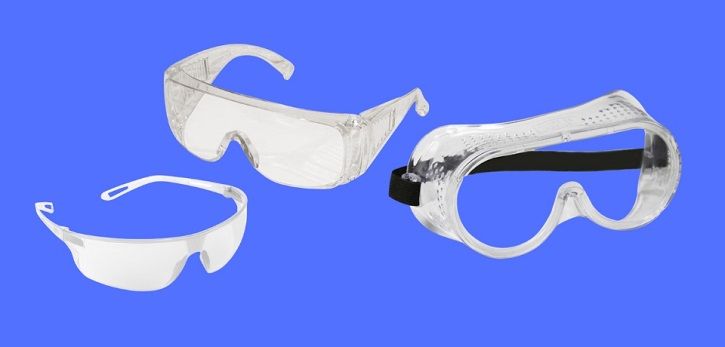UK DIY News
DIY Projects Result In 30,000 Eye Injuries Annually

According to the charity, Eye Health UK, every year 30,000 people require medical help for eye injuries caused by DIY projects. Many of these could have been prevented by wearing the correct safety eyewear.
In order to put a stop to avoidable eye injuries, trade and DIY tool supplier, Toolstation, have teamed up with Eye Health UK to educate amateur DIYers about how to protect their eyes when working with tools and household chemicals.
7 DIY tasks you should wear eye protection for
Toolstation’s safety eyewear experts explain that it’s better to be safe than sorry when it comes to DIY:
“Safety glasses and goggles are not expensive and can be picked up from most DIY shops. Our most affordable pair of safety glasses are just £1.78, while safety goggles can be purchased from £2.29.
“If in doubt about whether or not eyewear is needed for DIY, it’s always better to err on the side of caution. However, loosely speaking, there are seven key DIY tasks for which you should always wear safety glasses or goggles.”
1. Stripping paint
“Chemical paint strippers are highly toxic and volatile. If liquid paint stripper splashes into the eye, it can cause severe burning and even damage the cornea.”
2. Sanding wood
“When sanding wood, wood dust and splinters can fly up and into the eyes, causing irritation and lacerations. The natural chemicals contained in wood, as well as substances like mould and bacteria, can enter the eye and cause irritation and infections such as conjunctivitis.”
3. Welding
“Welding emits potentially harmful ultraviolet light radiation which can cause a range of eye injuries including photokeratitis (similar to sunburn of the eyes) and, in extreme cases, even contribute to cataracts. Always wear a full-face welding helmet with UV protection when welding.
“It’s worth stressing that welding can be a dangerous and difficult skill to master. It’s best to leave any welding work to skilled professionals.”
4. Painting ceilings
“A lot of people doing DIY may skip over the need for protective goggles that are essential when painting a ceiling.
“If you’ve ever kept your glasses on while rollering a ceiling, you’ll know how alarming it is to see how many paint splatters are covering your lenses after a few coats of the ceiling. If you don’t wear eye protection, all of this paint can end up in your eyes.”
5. Laying insulation
“With concerns about rising energy costs, many DIYers are taking on the task of laying loft insulation to improve the energy efficiency of their home. Fibreglass insulation is a synthetic fibre composed mainly of glass. The fibres of fibreglass insulation are extremely small, making them easy to come into contact with the skin, eyes, or lungs. So, if you're working with it, be sure to take safety seriously.
Wear some goggles with side shields to protect your eyes from any flying fibres. You should also consider wearing long-sleeved PPE clothing, a face mask, and gloves.”
6. Hammering
“When using a hammer, small high-velocity particles can fly off of the surface and penetrate the eye. A pair of safety glasses with side shields should be worn to stop this from happening.”
7. Drilling into masonry
“We’d always advise wearing a pair of clean goggles when drilling into masonry. This is because the dust that can fly into your eyes when you’re drilling can be corrosive. Added to this, chips of masonry can fly up into the eyes.
“There is also an increased risk of dust and small particles entering the eye when grinding or sanding. So, ensure protection is worn for these tasks too.”
8 vital tips for protecting your eyes
David Cartwright, optometrist and chair of Eye Health UK, has eight further must-follow tips for anybody carrying out home improvement projects:
1. Wear the right eye protection
“It’s important to wear the right eye protection when carrying out DIY tasks or handling chemicals. Always check that your safety eyewear meets the appropriate British Standard and/or British Standard European Norm - look for a CE and/or UKCA marking.
“Safety glasses with side shields provide the best all-round protection. When welding you require additional protection with a fitted welders mask and protection that carries the BS EN 169 safety mark.
“All common types of welding produce potentially harmful ultraviolet, infrared and visible spectrum radiation therefore it is vital to wear UV goggles or masks that protect from UV light. Auto-darkening filters have become one of the most common forms of protecting welders' eyes as they keep out harmful radiation.”
2. Ensure your eye protection fits properly
“It’s just as important to ensure any eyewear fits correctly. Eye protection should fit firmly but not tightly, sitting close to your eyes without the eyelashes touching the lens.
“If you wear prescription eyewear, make sure it fits comfortably under any non-prescription goggles or safety glasses. And remember, wearing normal spectacles or contact lenses on their own does not offer sufficient protection.”
3. Don’t remove your contacts or spectacles
“If you have poor eyesight, it’s important you follow the advice of your optician when it comes to wearing prescription contact lenses or spectacles. Intricate DIY tasks may require good near vision.
“Most safety glasses and goggles can be worn on top of slim spectacles but it’s also possible to buy prescription safety eyewear.”
4. Use appropriate tools
“Never improvise when it comes to DIY tools. You are more at risk of being involved in a potentially harmful accident if you don’t have the appropriate tools. If you don’t have the right tool for the job, wait until you have the correct one - whether that means purchasing new, borrowing from a friend or relative, or calling in a professional.”
5. Ensure adequate lighting
“Always ensure there is adequate lighting when carrying out any DIY job. If possible, position yourself near a window within daylight hours. You can also pick up portable site work lights very affordably.”
6. Never remove protective guards
“When working with power tools, always keep the protective guard in place. As well as preventing body parts from making contact with dangerous moving parts, these also protect the eyes from sparks and flying materials.”
7. Read the label
“When working with chemicals and liquids, always read the manufacturer’s guidance and storage instructions (safety data sheets are available). It’s also paramount to wash your hands thoroughly after handling chemicals as you touch your face and eyes much more than you’d expect. It could cause serious damage to your eyes or skin if you accidentally touch them with chemicals on your hands.”
8. Know what to do if things do go wrong and when to call in a pro
“Before you start, make sure you have first aid equipment and eyewash, and have read the appropriate usage instructions. You need to know where it is stored and ensure it is easily to hand in case of an accident.
“Do not rub the eye. This will make matters worse, increasing the chance of sight loss or permanent damage. Seek medical attention promptly.
“Never wash a cut or punctured eye. Cuts should be bandaged lightly if possible. If you believe you have an abrasion or laceration, you may need medical attention and should seek medical advice.
“If you feel out of depth with a DIY job, it’s always better to call a qualified professional. Taking risks by attempting a DIY task you’re unsure about can result in serious injury - and a botched job.”
Source : Toolstation
Thank you for the excellent presentation that you gave at Woodbury Park on Thursday morning. It was very interesting and thought-provoking for our Retail members. The feedback has been excellent.











































